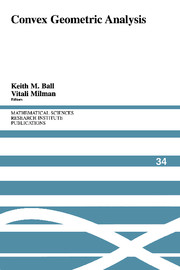Book contents
- Frontmatter
- Contents
- Introduction: The Convex Geometry and Geometric Analysis Program MSRI, Spring 1996
- Msri Program Seminars
- Integrals of Smooth and Analytic Functions over Minkowski's Sums of Convex Sets
- Localization Technique on the Sphere and the Gromov-Milman Theorem on the Concentration Phenomenon on Uniformly Convex Sphere
- Geometric Inequalities in Option Pricing
- Random Points in Isotropic Convex Sets
- Threshold Intervals under Group Symmetries
- On a Generalization of the Busemann-Petty Problem
- Isotropic Constants of Schatten Class Spaces
- On the Stability of the Volume Radius
- Polytope Approximations of the Unit Ball of ℓnp
- A Remark about the Scalar-Plus-Compact Problem
- Another Low-Technology Estimate in Convex Geometry
- On the Equivalence Between Geometric and Arithmetic Means for Log-Concave Measures
- On the Constant in the Reverse Brunn-Minkowski Inequality for p-Convex Balls
- The Extension of the Finite-Dimensional Version of Krivine's Theorem to Quasi-Normed Spaces
- A Note on Gowers' Dichotomy Theorem
- An "Isomorphic" Version of Dvoretzky's Theorem, II
- Asymptotic Versions of Operators and Operator Ideals
- Metric Entropy of the Grassmann Manifold
- Curvature of Nonlocal Markov Generators
- An Extremal Property of the Regular Simplex
- Floating Body, Illumination Body, and Polytopal Approximation
- A Note on the M*-Limiting Convolution Body
A Note on Gowers' Dichotomy Theorem
Published online by Cambridge University Press: 27 June 2025
- Frontmatter
- Contents
- Introduction: The Convex Geometry and Geometric Analysis Program MSRI, Spring 1996
- Msri Program Seminars
- Integrals of Smooth and Analytic Functions over Minkowski's Sums of Convex Sets
- Localization Technique on the Sphere and the Gromov-Milman Theorem on the Concentration Phenomenon on Uniformly Convex Sphere
- Geometric Inequalities in Option Pricing
- Random Points in Isotropic Convex Sets
- Threshold Intervals under Group Symmetries
- On a Generalization of the Busemann-Petty Problem
- Isotropic Constants of Schatten Class Spaces
- On the Stability of the Volume Radius
- Polytope Approximations of the Unit Ball of ℓnp
- A Remark about the Scalar-Plus-Compact Problem
- Another Low-Technology Estimate in Convex Geometry
- On the Equivalence Between Geometric and Arithmetic Means for Log-Concave Measures
- On the Constant in the Reverse Brunn-Minkowski Inequality for p-Convex Balls
- The Extension of the Finite-Dimensional Version of Krivine's Theorem to Quasi-Normed Spaces
- A Note on Gowers' Dichotomy Theorem
- An "Isomorphic" Version of Dvoretzky's Theorem, II
- Asymptotic Versions of Operators and Operator Ideals
- Metric Entropy of the Grassmann Manifold
- Curvature of Nonlocal Markov Generators
- An Extremal Property of the Regular Simplex
- Floating Body, Illumination Body, and Polytopal Approximation
- A Note on the M*-Limiting Convolution Body
Summary
We present a direct proof, slightly different from the original, for an important special case of Gowers’ general dichotomy result: If X is an arbitrary infinite dimensional Banach space, either X has a subspace with unconditional basis, or X contains a hereditarily indecomposable subspace.
The first example of dichotomy related to the topic discussed in this note is the classical combinatorial result of Ramsey: for every set A of pairs of integers, there exists an infinite subset M of ℕ such that, either every pair ﹛m1, m2﹜ from M is in A, or no pair from M is in the set A. There exist various generalizations to “infinite Ramsey theorems” for sets of finite or infinite sequences of integers, beginning with the result of Nash-Williams [NW]: for any set A of finite increasing sequences of integers, there exists an infinite subset M of N such that either no finite sequence from M is in A, or every infinite increasing sequence from M has some initial segment in A (although it does not look so at the first glance, notice that the result is symmetric in A and AC, the complementary set of A; for further developments, see also [GPl, [E]). The first naive attempt to generalize this result to a vector space setting would be to ask the following question: given a normed space X with a basis, and a set A of finite sequences of blocks in X (i.e., finite sequences of vectors (x1, … , xk) where x1, … , xk ∈ X are successive linear combinations from the given basis), does there exist a vector subspace Y of X spanned by a block basis, such that either every infinite sequence of blocks from Y has some initial segment in A, or no finite sequence of blocks from Y belongs to A, up to some obviously necessary perturbation involving the norm of X.
Information
- Type
- Chapter
- Information
- Convex Geometric Analysis , pp. 149 - 158Publisher: Cambridge University PressPrint publication year: 1999
